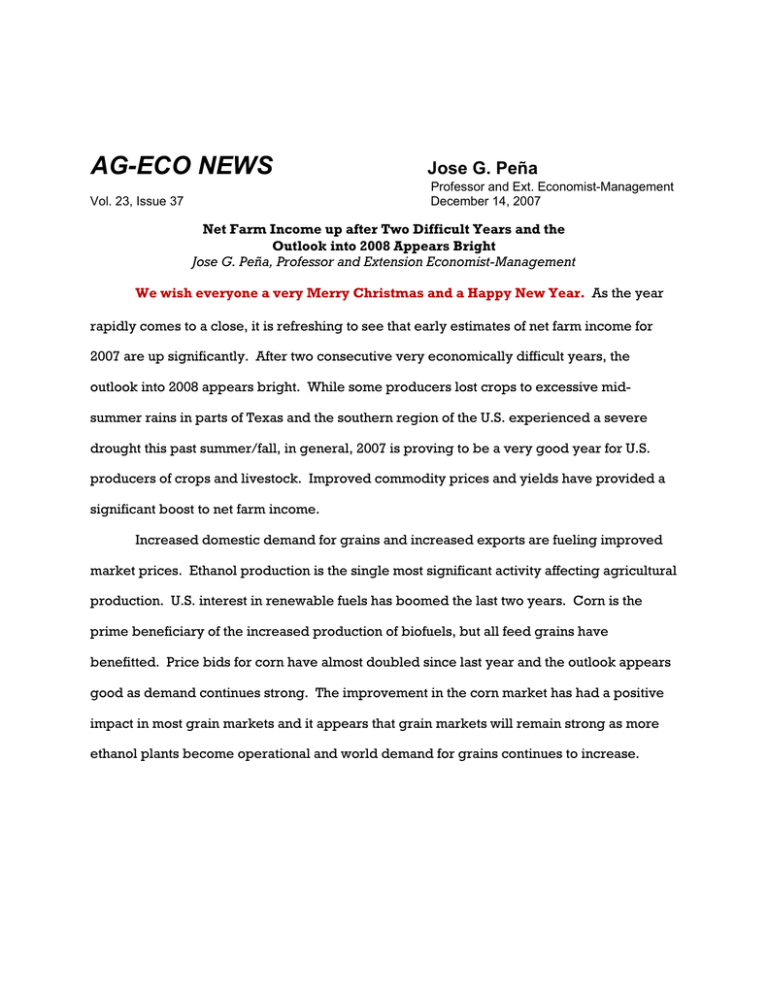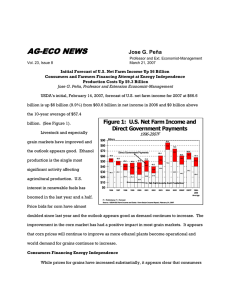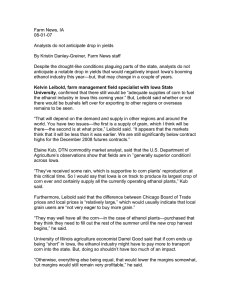AG-ECO NEWS Jose G. Peña
advertisement

AG-ECO NEWS Jose G. Peña Vol. 23, Issue 37 Professor and Ext. Economist-Management December 14, 2007 Net Farm Income up after Two Difficult Years and the Outlook into 2008 Appears Bright Jose G. Peña, Professor and Extension Economist-Management We wish everyone a very Merry Christmas and a Happy New Year. As the year rapidly comes to a close, it is refreshing to see that early estimates of net farm income for 2007 are up significantly. After two consecutive very economically difficult years, the outlook into 2008 appears bright. While some producers lost crops to excessive midsummer rains in parts of Texas and the southern region of the U.S. experienced a severe drought this past summer/fall, in general, 2007 is proving to be a very good year for U.S. producers of crops and livestock. Improved commodity prices and yields have provided a significant boost to net farm income. Increased domestic demand for grains and increased exports are fueling improved market prices. Ethanol production is the single most significant activity affecting agricultural production. U.S. interest in renewable fuels has boomed the last two years. Corn is the prime beneficiary of the increased production of biofuels, but all feed grains have benefitted. Price bids for corn have almost doubled since last year and the outlook appears good as demand continues strong. The improvement in the corn market has had a positive impact in most grain markets and it appears that grain markets will remain strong as more ethanol plants become operational and world demand for grains continues to increase. Increased export demand for grains due to reduced world production as a result of extended droughts in competitor countries and increased international consumption is Figure 1: Foreign Currency/US$ Exchange Rates reducing world supplies and boosting dollar that makes U.S. commodities cheaper in terms of local currencies of importing countries. In terms of international trade, weak U.S. dollars favor increased exports. See Figure 1 for an Euro/$ 1.200 1.150 1.100 1.050 1.000 0.950 0.900 0.850 0.800 0.750 0.700 1.15 euros/$1 $5/bu wheat = €5.75 0.869 euros /$1 $5/bu wheat = €4.35 0.78 euros/$1 $5/bu wheat = €3.90 Jan ‐02 Ap r‐0 2 Jul ‐02 Oc t‐0 Jan 2 ‐03 Ap r‐0 3 Jul ‐03 Oc t‐0 Jan 3 ‐04 Ap r‐0 4 J ul ‐04 Oc t‐0 Jan 4 ‐05 Ap r ‐0 5 J ul ‐05 Oc t‐0 Jan 5 ‐06 Ap r‐0 6 J ul ‐06 Oc t‐0 Jan 6 ‐07 Ap r ‐0 7 J ul ‐07 Oc t‐0 7 grain prices. This is aided by a weak example of a comparison of the cost of wheat in relation to foreign currency exchange rates. Improved markets for grain may mean a brighter outlook for crop agriculture, but they also mean higher feed costs for livestock agriculture. Typically, the spread between feeder and fed steer prices Figure 2: U.S. Corn Production and Total Use 1999-2007 14.00 Billion Bushels tightens as corn prices increase. However, limited numbers of all classes of cattle have Production 13.00 11.81 12.00 11.27 11.00 helped sustain cattle prices. 10.00 9.00 11.21 11.11 9.92 9.52 9.74 Corn 13.17 12.69 9.43 10.23 9.82 9.49 10.66 10.54 10.09 9.51 Total Use 8.97 8.00 After two years of production 7.00 1999 2000 2001 2002 2003 2004 2005 2006 2007 declines, USDA’s December 11, 2007 Source: World Agricultural Supply and Demand Estimates (WASDE);2007-December 11, 2007 estimate estimate of U.S. corn production for the 2007/08 at a record 13.17 billion bushels will exceed the current estimate of use. U.S. corn disappearance has outstripped production during five of the past seven years. (See Figure 2). Total use is expected to reach a record large 12.69 billion bushels in 2007/08, with the bulk of the increased demand attributed to increased ethanol production. The current estimate for ethanol use at 3.2 billion bushels is up 49% from last year and now accounts for about 23.4% of this season’s entire U.S. corn crop. As a result, it appears that the demand curve for corn has shifted to the right and we can expect to sustain the recent market improvement for the next few seasons. But, since ethanol use is one of the principal factors driving the market, increased demand can only be sustained if crude oil prices remain in the $60/barrel range or above. If prices drop significantly below this level, it may be difficult for ethanol to remain competitive without substantially increased incentives. What’s Ahead • In terms of Farm Bill 2007, as of this writing on Friday (12.14.07) , Congress is considering a three month extension to Farm Bill 2002 because the Senate is still bogged down in passing its version of the farm bill. Most farm bill provisions have operated under a temporary extension since the current farm bill law expired on September 30, 2007. Only five of the 40 amendments (out of 280 proposed) that the Senate agreed to discuss prior to voting on the Senate version have been rejected. Even if the Senate is able to plow through these amendments and the bill passes the Senate before the Christmas recess, a conference committee between the House and Senate must resolve any differences between the two versions. The President has to sign the legislation and it will probably take several months to translate the law into specific implementing regulations. • Some farm bill commodity provisions are less effective as a safety net. As market prices are likely to remain above the target price in the near-to-intermediate term, counter cyclical payments and marketing loan programs are basically non-factors. But, the farm sector is carrying more risk as production costs have increased about 16 percent since 2005 and with commodity prices at this higher level, markets carry increased volatility. While the percent fluctuation in prices will probably remain similar to the past, the value and impact of the fluctuation will be much higher. According to a University of Illinois report, grain price volatility has doubled over the past 5 years. Dr. Danny Klinefelter, Professor and Extension Economist-Management, explains this with a hypothetical example: when corn prices were averaging $2.00 per bushel, prices typically fluctuated within $.50 of that amount over the marketing year. At $4.00 corn, the fluctuations are more likely to be in the +/- $1.00 range. • Increased competition for acreage as farmers chase higher market prices of different commodities. • More food safety regulations with trace back audit trails, will probably be implemented as a result of the recent series of E-Coli contaminated food products. • Increased demand for organic products. • Increased demand for source and processed verified livestock. • Increased use of Genetically Modified Organisms (GMOs) as producers attempt to reduce energy/labor intensive production costs. In addition, GMO’s are adding substantial attribute enhancement features for consumers and industrial applications, such as drought resistant varieties. • A slight improvement in the availability of Ag labor as a slow-down in home construction frees-up labor. • Passage of immigration reform legislation will probably be delayed until after the 2008 election. • Increased reliance on technology, the Internet and electronic market linkages. For example, traditional open bid commodity markets for animals are fading in importance and most animals are marketed through contracts, cooperatives and a variety of arrangements that link production with processing and retailing of final products.







